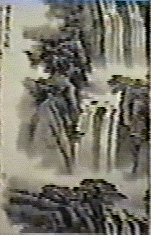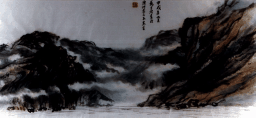
 |
Part Two: The Buddhist Sanskrit Text with Interlinear Vocabulary
Part Three: A Glossary of Zen Buddhist Terms

This text is modified from:
Hurtz, Leon. Hsuan-tsang (602-664) and the Heart Scripture in Prajnaparamita and Related Systems: Studies in Honor of Edward Conze (University of California at Berkeley Press). 103-113.
Hurtz describes this text as "brahmanical" and reports that Hsuan-tsang transcribed it in Chinese characters from a wall of a cave at Ta hsing-shan-ssu in Lo-yang, China, apparently on the Silk Road, during the 7th century A.D. The context in which the Chinese scholar presented the Hridaya Sutra makes it clear that he considered it a magical text. Although this text is not precisely identical with existing English translations of "The Heart Sutra," it is obviously consistent with the Hridaya textual tradition. The Sanskrit scans metrically and by sense into mostly four line verses, a classical verse form that suggests a strong literary value in the text. Repetitions and thematic emphasis on the pervasiveness of emptiness (sunyata) characterize the text. I found that in order to preserve the sense of the verses it was necessary to shorten one verse to three lines, to lengthen another verse to five lines.
I modified the Hurtz text by eliminating all Sanskrit diacritical marks, regularizing the spacing of the Sanskrit words and their spelling, and adjusting the lines of the text according to sense and (in some cases) meter. I used Hurtz's interlinear vocabulary as a base and added to it. The difficulties in this text are partly due to the obscurities of Buddhist Sanskrit, partly to the awkardness of the transcription into Roman letters from Chinese phonological equivalents by Hurtz, and mostly to my radically imperfect knowledge of Sanskrit. I accept full responsibility for the errors experts in the Sanskrit language will find here.
May the merit of this effort benefit all sentient beings.

aryavalokitesvaro bodhisattvo
(Avalokateshvara bodhisattva)
gambhiram prajnaparamita caryam caramano vyavalokayati
(deep perfect wisdom action perform luminously)
sma panca skandhas tams ca sva bhava sunyam
(saw five bundles them own nature empty)
pasyati sma iha sariputra
(? saw oh Sariputra)
rupam sunyata va rupam rupan na prithak
(form emptiness evidently form form not different)
sunyata sunyataya na prithag rupam
(emptiness emptiness not different form)
yad rupam sa sunyata ya sunyata sa rupam
(this form that emptiness this emptiness that form)
evam eva vedana samjna samskara vijnanam
(like this feeling thought choice consiousness)
iha sariputra sarva dharma sunyata
(oh Sariputra all dharmas emptiness)
laksana anutpanna anruddha avmala anuna aparpurna
(mark not born not pure not increase not decrease ?)
ta sariputra sunyatayam
(therefore Sariputra in the middle of emptiness)
na rupam na vedana na samjna na samskara na vijnana
(no form no feeling no thought no choice no consciousness)
na caksuh srotam na ghrana jihva kaya manah
(no eye ear no nose tongue body mind)
na rupa sabda gandha rasa spistavya dharmah
(no form sound smell taste touch dharmas)
na caksur dhatur ya van na mano vijnanam dhatur
(no eye-area up to no mind-consciousness area)
na vidya na vidya na vidya ksayo va vidya ksayo
(no clarity no clarity no clarity exhaustion no clarity exhaustion)
ya van jaramaranam na jaramarana ksayo
(up to old age no old age exhaustion)
na duhkha samudaya nirdoha margajna
(no suffering end of suffering path)
na jnanam na prapti na bhismaya tasmai na prapti
(no knowledge no ownership no witnessing no thing to own)
tvad bodhisattva prajnaparamita asritya
(therefore bodhisattva perfect wisdom dwells)
viha ratya citta varano vidya ksayo na vidya ksayo
(in dwell thought no obstacle clarity exhaustion not clairty exhaustion)
ya van jaramaranam na jaramarana ksayo
(up to old age no old age exhaustion)
na duhkha samudaya nirodha margajna
(no suffering end of suffering path)
na jnanam na prapti na bhismaya tasmai na prapti
(no knowledge no property no witnessing no thing to own)
tvad bodhisattvanam prajnaparamita asritya
(therefore bodhisattva perfect wisdom dwells)
viha ratya citta varano citta varano
(in dwell thought no obstacle thought no obstacle)
na siddhitvad atrasto vipa ryasa ti kranto
(no existence fear fright inverse reverse ? separate)
ni stha nirvana tya dha vyava sthitah
(perfectly stands nirvana three worlds thing experiences)
sarva buddhah prajnaparamitam asritya
(all buddhas perfect wisdom dwell)
(a?)nuttaram samyaksambodhim abdhisambuddhah
(unexcelled ultimate perfect insight together ? buddhas)
ta smai jnata vyam
(therefore should know ?)
prajnaparamitamahamantram mahavidyamantram
(perfect wisdom great charm great clear charm)
anuttaramantram asamasama mantram
(unexcelled charm unequalled equal charm)
sarva duhkha prasa manam sa tyam ami thyatvat
(all suffering stop terminate genuine real not vain)
prajnaparamitayam ukto mantrah tadyatha
(perfect wisdom declaired charm saying)
GATE GATE PARAGATE PARASAMGATE BODHI SVAHA
(gone gone totally gone totally completely gone enlightened so be it)
prepared by: Dr. Michael E. Moriarty Communication Arts Department Valley City State University Valley City, North Dakota 58072

by Stan Rosenthal
Source: Steven E. Newton
 |
THE ART OF CHINA AT THE NATIONAL GALLERY
or see works from
BANGLADESH |
BURMA |
JAPAN |
INDIA
INDONESIA |
NEPAL |
PAKISTAN |